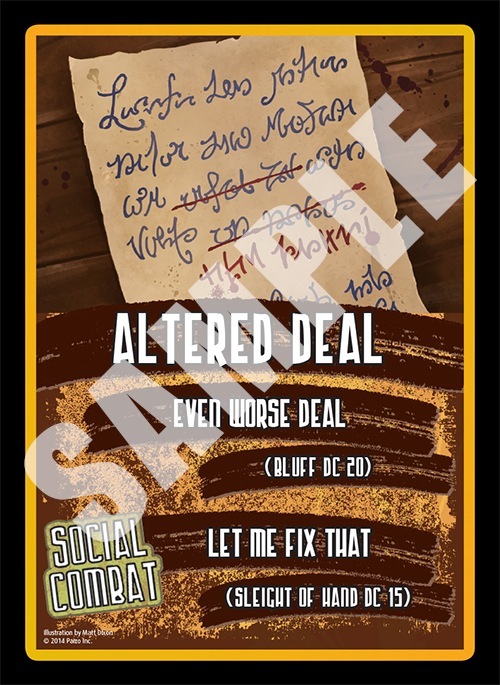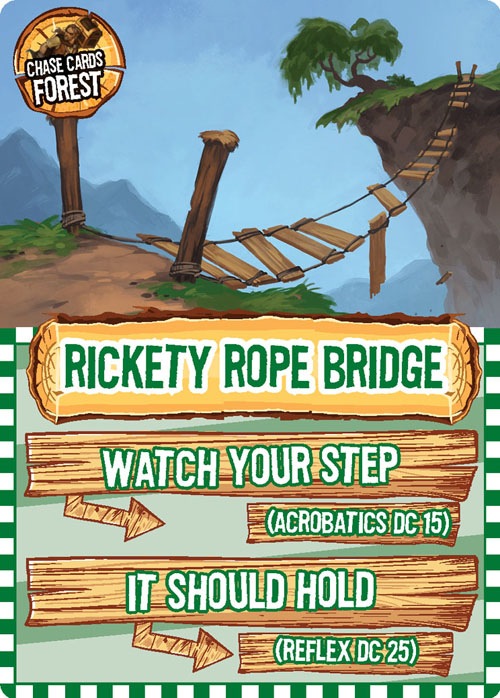Last year when I was writing my round 5 adventure pitch for RPG Superstar, I bought the Chase Cards deck because I wanted to include a chase encounter in my adventure and wanted to mine the deck for ideas. This year at PaizoCon, my loot bag included the Social Combat deck, and I was thrilled to notice that the mechanics are very similar to those of the Chase Cards deck. In this article I'll discuss how these two decks have affected the way I see skills as part of encounter design.
In both decks, each card represents a problematic situation that requires a skill check to resolve. In the Chase Cards deck, each card is an obstacle (such as an angry dog barking in a narrow alley) that you have to tackle before you can move onward. In the Social Combat deck, each card is social encounter (such as a negotiation). What the decks have in common is that each card has two skill check DCs on it, and a PC has to pick one of the skills and make a successful skill check to beat the card. Using the angry dog example above, the two skill checks could be Handle Animal (to make the dog calm down) and Acrobatics (to jump over / tumble past the dog).
 |
| From paizo.com |
In the Social Combat deck, the first skill listed represents the "standard" way of solving the problem, and the second skill is an alternative way of doing it. Actually, the deck has four suits, corresponding to the four social skills of the Pathfinder RPG: Bluff, Diplomacy, Intimidate, and Sense Motive, and the first skill listed on a card always matches the suit of the card. The second, or alternative skill on the other hand can be nearly anything: Perform (acting), Profession (any), Sense Motive, Knowledge (planes), Disguise, Appraise, Linguistics, or Heal, to name a few examples. Some of the cards even have ability checks as alternatives.
 |
| From paizo.com |
The Chase Cards deck goes even further in its imaginativeness. While most of the checks listed are skill checks, sometimes a card offers a saving throw or a combat maneuver check as an alternative. Why do I think it's important or at least useful to include two skills to solve a problem?
- In my opinion, there should always be at least two different ways to solve a problem.
- Everyone should be allowed to participate even if they didn't put ranks in the "right" skill. Players shouldn't be penalized too heavily for playing a particular type of character. Ability score checks, saving throws, and combat maneuver checks are great (when they make sense!) because even the dumbest martial character can contribute meaningfully. Even when you're just using skill checks, if possible, and again, if it makes sense, it's good to include checks with different ability modifiers and skills from different class lists.
In my Pathfinder Society scenario,
the Golden Guardian, I often included two options for skill checks. For instance, a particular encounter (that apparently has made a lot of players like a creature you'd normally fear) made use of this technique quite extensively. It's possible to identify different types of objects (various skill checks), analyze the creature's behavior (Sense Motive or a Knowledge check of the right type), interact with the creature (wild empathy, Bluff, or Handle Animal), identify something created by the creature (Sense Motive or a particular type of Craft), figure out how the creature created that something (one of two Knowledge checks), interrogate a person (Diplomacy or Intimidate), identify something the creature has left behind (a Knowledge check or Survival), and so on.
It's useful to remember that the skill descriptions in the
Core Rulebook are quite restrictive, and if you follow them too slavishly, you'll find it hard to use this approach with skills. I think it's better to look for reasons to allow the use of a skill than to look for reasons to disallow it. Allowing more players to contribute is always good for the game.
--
This blog post uses trademarks and/or copyrights owned by Paizo Inc., which are used under Paizo's Community Use Policy. We are expressly prohibited from charging you to use or access this content. This blog post is not published, endorsed, or specifically approved by Paizo Inc. For more information about Paizo's Community Use Policy, please visit paizo.com/communityuse. For more information about Paizo Inc. and Paizo products, please visit paizo.com.



Great post. Top to bottom, I agree.
ReplyDeleteI own, and have used the Chase Cards Deck a few times — once you learn the concept, it's easy to incorporate your own twists by filling in the blanks.
To increase the chances of different players being able to contribute, you can also increase the number of skills for each "half" of the card. In your example with the angry dog, you could allow either an Acrobatics check or a Reflex save to avoid the dog "physically", and a Handle Animal, Knowledge (nature), Bluff or Intimidate check to avoid the dog "mentally" (player's choice).
Since you used the Rickety Rope Bridge card as an example, I'll point out that that card in particular has what I consider a small drawback — having two options that are likely to both be strong or weak for the same character. I might allow a player to choose from additional intelligence-based checks for the Watch Your Step option, such as Knowledge (engineering) or simply an Intelligence check.
I'll have to buy the Social Combat Deck, now that you've piqued my interest. In my bag from PaizoCon, I got Pathfinder Cards: Tides of Battle! Next weekend, I'll be trying them out for the first time in a homebrew campaign I run.
That encounter struck me as a great example of a non-combat encounter done right.
ReplyDeletewww.chase.com/verifycard - Activate & Verify Chase Credit Debit Cards. We have provided a quick “how to” activation guide below so that you
ReplyDeletechase com verifycard